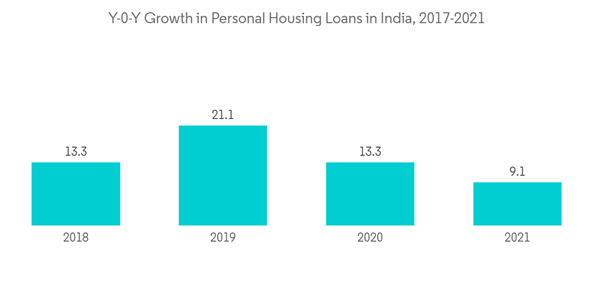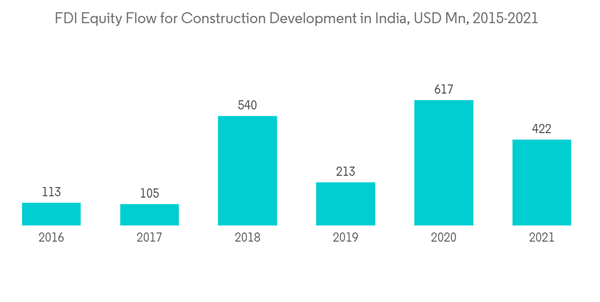Concealed cistern contributes to a cleaner, more minimalist style bathroom that's both easy to maintain and effortlessly stylish, and instead of being on display, they are concealed. With India aiming toward a defecation-free India, the share of India's population with access to a household toilet has increased from 84.3% in 2017-18 to almost 100% in 2020. A total of 110 million household toilets were built between 2014-20. This increase in the use of toilets creates an opportunity for concealed cisterns and creates innovations in the toilet market.
During the first covid wave in 2020, the contraction in economic growth was driven primarily by supply disruptions due to a prolonged nationwide lockdown. Real estate, as well as the utility market used in kitchens and bathrooms including concealed cisterns, observed a sudden decrease in demand. Housing affordability of people declines with a reduction in discretionary income.
The market size of the real estate industry is continuously increasing since 2017, with a revenue of around USD 220 bn in 2021. Cities with the maximum construction of new residential property in India during 2021 are Mumbai metropolitan, Pune, Hyderabad, NCR and Bengaluru. With these cities generating maximum revenue and formal employment, they will create a market for concealed cistern.
India Concealed Cistern Market Trends
Real Estate Industry Market Affecting Concealed Cistern Market
The market size of the real estate industry in India is observing a continuous increase with around USD 180 billion in 2020 and is expected to increase to USD 1000 billion by 2030. With the advent of COVID-19, investment in infrastructure as a share of India's GDP observe a continuous decline with 4.4% in 2019, 4.2% in 2020, and 3.9% in FY 2021 and having a negative transmission effect on other markets connected to real estate.In budget 2022, the government’s decision to allocate INR 48,000 crore in the Budget under the Pradhan Mantri Awas Yojana (PMAY) and faster approvals for affordable housing in urban areas and two of the biggest governmental programs in recent years, the “Smart City Mission” and the “National Infrastructure pipeline”, containing goals on sustainability, environmental protection and disaster risk management. These programs led to an increase in modern bathrooms leading to an increase in demand for concealed cisterns.
Construction Sector FDI in India Driving Concealed Cistern Market
Various central government and state government initiatives during COVID-19 have helped the real estate industry remain buoyant through 2020 in India. Infrastructure activities in 2021 were second largest by the distribution of foreign direct investment equity inflow in India receiving around INR 582.4 billion of which Maharashtra received the largest after which comes Delhi, Karnataka, and Tamil Nadu. From April 2000 to June 2021 India received USD 51.5 bn as FDI in construction. The largest infrastructure investment comes from Singapore in 2021 contributing USD 25.8 bn. This investment in infrastructure-related activities leads to an increase in the construction of bathrooms in commercial as well as residential spaces increasing the demand for concealed cisterns.India Concealed Cistern Market Competitor Analysis
The report covers major players operating in the concealed cistern market along with their product portfolio, key financials, and recent developments. The market is transforming with many technological advancements through product innovation. The key market players are focusing on improving their product quality which will help them to increase their share in the opportunistic Indian market. All major companies including Kohler, Jaquar, Hindware, etc. are making available their products available in the online market and competing for an increase in market share and revenue in online business.Additional Benefits:
- The market estimate (ME) sheet in Excel format
- 3 months of analyst support
Table of Contents
Companies Mentioned (Partial List)
A selection of companies mentioned in this report includes, but is not limited to:
- Cera
- Parryware Limited
- Roca
- Jaquar
- Hindware
- Kohler
- Toto India Industries Pvt. Ltd.
- H&R Johnson (India) Ltd
- Duravit India
- Somany Ceramics
Methodology

LOADING...










